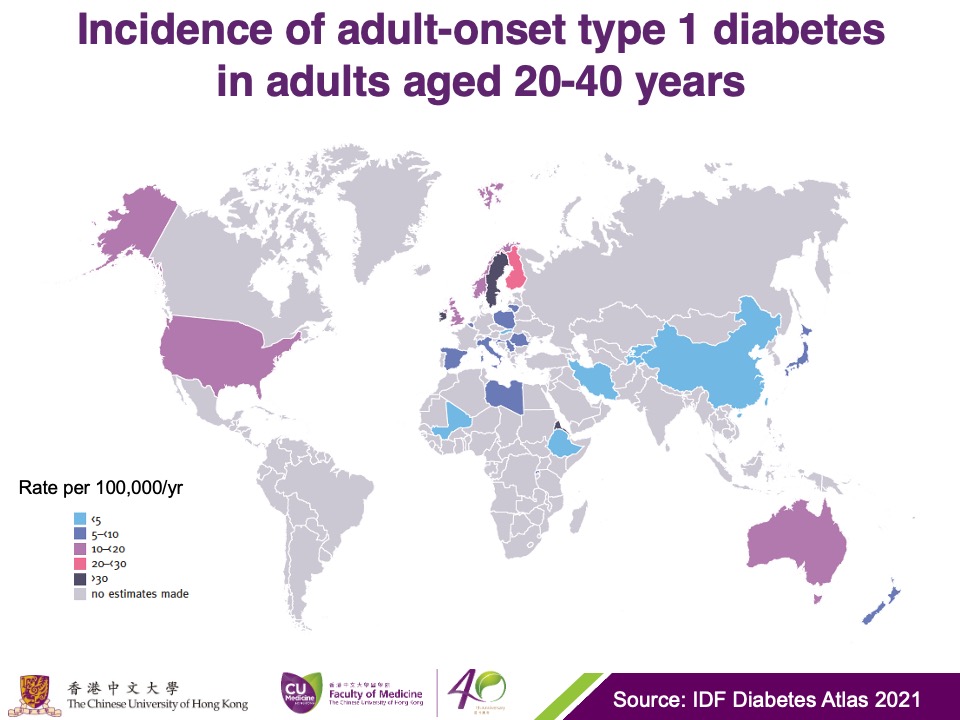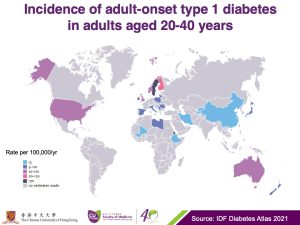CUHK
News Centre
International study led by CU Medicine highlights significant global incidence of newly diagnosed type 1 diabetes among adults much higher than previously believed
Type 1 diabetes is generally considered a childhood-onset disease, and patients rarely present with it in adulthood. However, one of the largest global studies of its kind, led by The Chinese University of Hong Kong (CUHK)’s Faculty of Medicine (CU Medicine), found that there is a significant incidence of type 1 diabetes among adults with newly diagnosed diabetes, which is much higher than previously believed. The number of new cases also did not appear to decline with increasing age, and a significant number of new cases presenting late in life. In addition, the incidence varied considerably by geographical region, while the rates are overall higher in men than women. The results have been published in the journal Diabetes Care.
Revealing the global pattern of type 1 diabetes presenting in adults
Type 1 diabetes is an autoimmune condition whereby the immune system attacks the cells responsible for producing insulin in the body, resulting in severe insulin deficiency and elevated blood glucose. Once developed, people with type 1 diabetes require lifelong treatment with insulin. This year marks the centenary of the first injection of insulin for the treatment of diabetes, and insulin has now become an indispensable treatment for type 1 diabetes.
This collaborative study examined 46 studies in relation to type 1 diabetes from 32 countries and regions between 1990 and 2021. Professor Ronald Ching Wan MA, Head of the Division of Endocrinology and Diabetes (Academic Affairs), Department of Medicine and Therapeutics at CU Medicine, and senior author of the study, remarked, “What was most notable from our review was that among studies where data was available, there was no clear relationship between age and the rates of type 1 diabetes presenting in adults – in other words, the number of new cases did not appear to decline with increasing age, highlighting the significant incidence of type 1 diabetes diagnosed later in life. This contrasts with the traditional thinking that cases of type 1 diabetes rarely present in adulthood.” Among studies that reported the incidence of type 1 diabetes across age categories (20-39, 40-59 and ³60 years), 5 of 12 studies (42%) reported an increase in type 1 diabetes incidence with age.
The study also revealed the global pattern of type 1 diabetes presenting in adults. A more than 30-fold difference was found in the annual rates of type 1 diabetes presenting in adults, ranging from less than 1 per 100,000 in China to more than 30 per 100,000 in Sweden. Among the 26 studies which reported rates in males and females, 92% reported a higher incidence in adult males compared with females.
A new index to evaluate the quality of studies on type 1 diabetes
Considering that most of the past studies on this topic were from high-income countries, highlighting the paucity of data from low-to-middle-income countries, there is a pressing need for more well-designed studies in order to understand the true problems that type 1 diabetes causes in different parts of the world. The research team developed an index to evaluate the quality of the studies, including the incorporation of biomarkers to ascertain the diagnosis of type 1 diabetes, which will help improve the design of future studies.
Professor Ma added, “Most adults presenting with diabetes are likely to be diagnosed with type 2 diabetes, which can be controlled by oral medications in the early stages. The key challenge now becomes how best to identify the significant numbers who in fact have underlying type 1 diabetes, to ensure they receive appropriate treatment, in particular early insulin therapy. The correct classification of the underlying pathogenesis, either type 1 and type 2 diabetes, is an important part of personalising and optimising diabetes treatment for patients.”
The institutions participating in the study spanned the globe, including CUHK; Emory University, USA; the University of Sydney, Australia; Exeter University, UK; Central South University, China; the University of Washington, USA; Baker Heart and Diabetes Institute, Australia; and the International Diabetes Federation. Some results from the study have also been included in the latest International Diabetes Federation Diabetes Atlas (10th edition).

Professor Ronald MA, Head of the Division of Endocrinology and Diabetes (Academic Affairs), Department of Medicine and Therapeutics at CU Medicine, and senior author of the study, remarks that the key challenge now is how best to identify the significant numbers who in fact have underlying type 1 diabetes, to ensure they receive appropriate treatment, in particular early insulin therapy.





